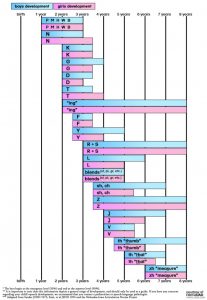I recently spoke at the IAHE (Indiana Association of Home Educators) Convention and it was amazing! I was so thankful to speak to many parents about their concerns regarding the speech and language of their children. I compiled a list of frequently asked questions and will be sharing them here in a blog series.
The number one question I kept answering was “My child can’t say ____. Is that normal?” It can be difficult to know if your child’s difficulty with certain sounds is age appropriate and when to be concerned, hence this blog post was born.
There has been a lot of research done on speech sound (or phoneme) acquisition. An easy way to check and see if your child has a possible speech disorder is to google a “speech sound acquisition chart”. This is a chart stating what sounds a child should have in their phonemic repertoire by what age. It is separated by boys and girls because girls tend to develop certain sounds earlier than boys.
Here is an example:

You use the chart by finding the sound with which your child is struggling (for example, /l/). You can see that /l/ typically develops around age three. The “cut off” age for a typical developing /l/ sound is age five for girls and age six for boys. If your child is a boy who is seven and he cannot say /l/ correctly, then that would indicate a possible speech disorder because he should have achieved correct pronunciation of that sound by age six.
Just because a child does not have a certain sound by the accepted age range does not mean that anything is “wrong”. Sometimes they may just need a little push to start self-monitoring or to correct a learned habit of mispronunciation. If you notice multiple errors, your child may demonstrate a phonological processing disorder. This means that errors follow a pattern.
Once you have looked at this chart and noticed any sounds your child has not mastered by the cutoff, I would suggest contacting a speech therapist for their clinical opinion and a possible in-depth evaluation of your child’s speech. Treating misarticulations EARLY is beneficial to progress as misarticulations can become hard to unlearn because they are ingrained habits. Speech sound disorders can also have a negative impact on a child’s reading and spelling ability.
I hope this helps to provide a resource to either set your mind at ease or set you on the right path to getting your child help! Please keep in mind that articulation is not the only area in which children can demonstrate a speech disorder. Articulation trouble can also be related to phonemic awareness and phonological awareness disorders (the latter can also stand on their own). If you have ANY concerns about your child’s speech or language, please feel free to contact me and I’m happy to offer a free consultation to let you know your next steps.
